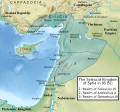Fail:Syria under the Seleucids 95 BC.svg

Selle SVG-faili PNG-vormingus eelvaate suurus: 644 × 600 pikslit. Teised eraldusvõimed: 258 × 240 pikslit | 516 × 480 pikslit | 825 × 768 pikslit | 1100 × 1024 pikslit | 2200 × 2048 pikslit | 1014 × 944 pikslit.
Algfail (SVG-fail, algsuurus 1014 × 944 pikslit, faili suurus: 2,6 MB)
Faili ajalugu
Klõpsa kuupäeva ja kellaaega, et näha sel ajahetkel kasutusel olnud failiversiooni.
| Kuupäev/kellaaeg | Pisipilt | Mõõtmed | Kasutaja | Kommentaar | |
|---|---|---|---|---|---|
| viimane | 30. juuni 2018, kell 19:42 |  | 1014 × 944 (2,6 MB) | Cplakidas | fixing things missed from original map: correcting border at Gadara; adding Galilee as a region, changing Judea to font denoting a state; adding Nisibis |
| 30. juuni 2018, kell 19:35 |  | 1014 × 944 (2,59 MB) | Cplakidas | User created page with UploadWizard |
Faili kasutus
Seda faili kasutab järgmine lehekülg:
Globaalne failikasutus
Järgmised muud vikid kasutavad seda faili:
- Faili kasutus vikis en.wikipedia.org
- Faili kasutus vikis id.wikipedia.org
- Faili kasutus vikis ru.wikipedia.org
- Faili kasutus vikis uk.wikipedia.org
- Faili kasutus vikis vi.wikipedia.org
- Faili kasutus vikis zh.wikipedia.org